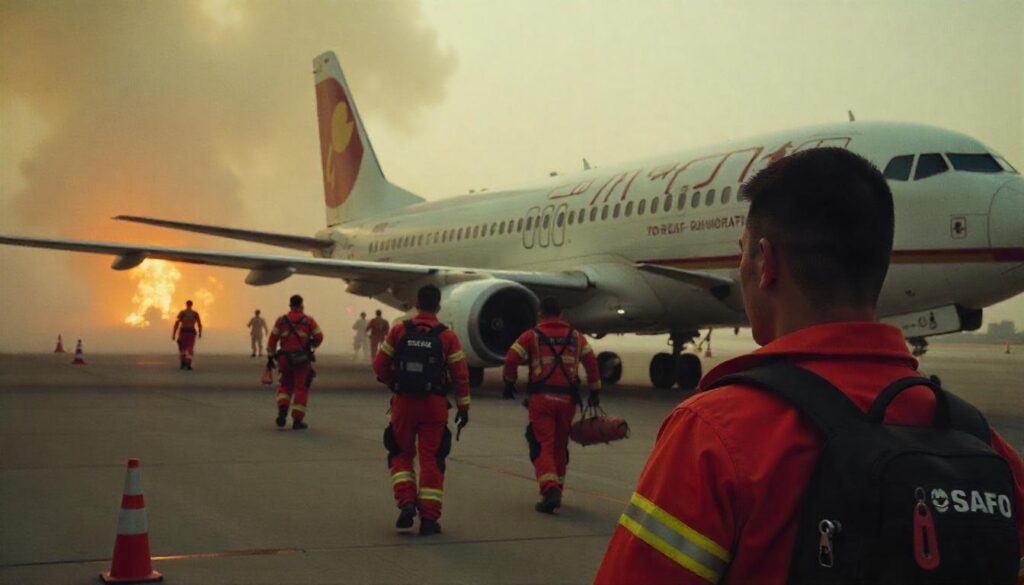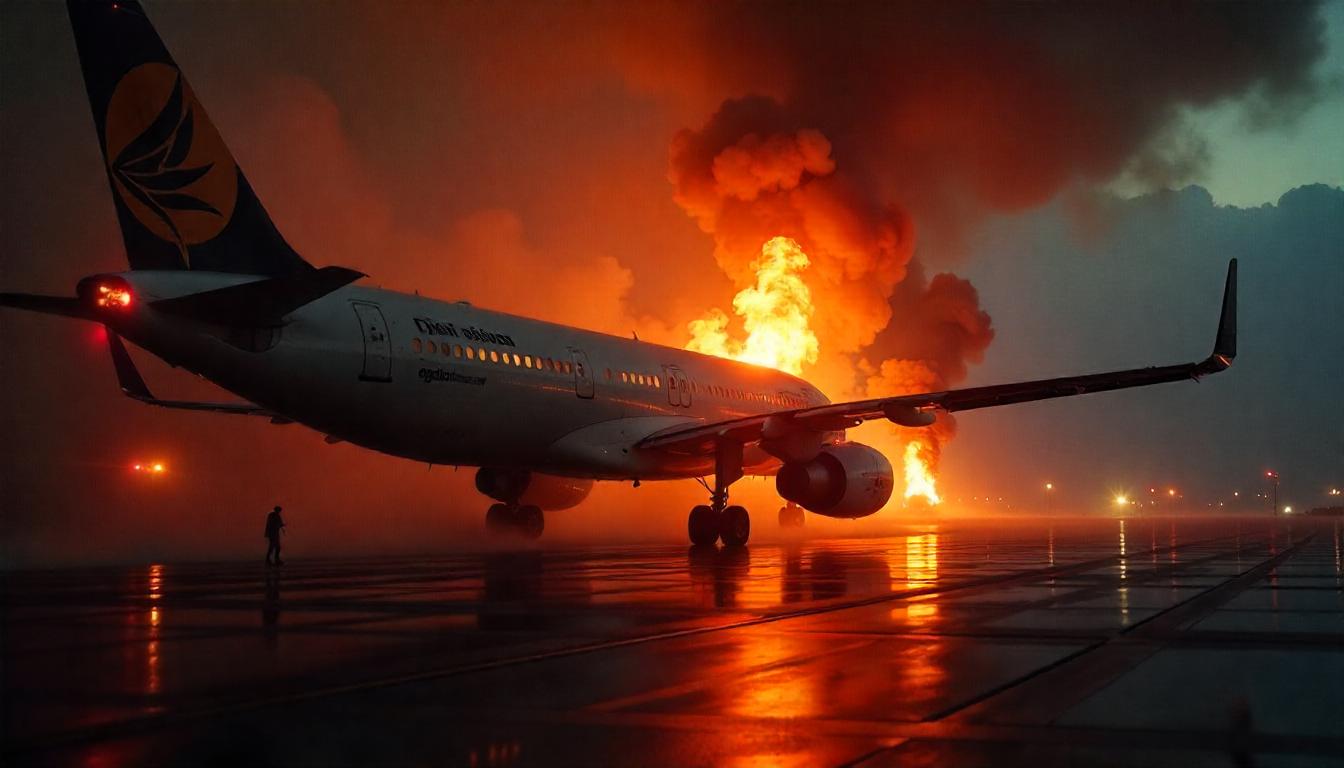In 2014, an aviation emergency in Vietnam captured the attention of the world, showcasing the resilience, training, and heroism of rescue teams. Known as the “Plane Fire Rescue 2014 vietsub,” this incident highlighted the importance of emergency preparedness in aviation and the extraordinary courage required to save lives in perilous conditions.
Aviation incidents demand swift and efficient action to prevent loss of life. The Plane Fire Rescue 2014 vietsub stands out as a moment where courage, coordination, and skill converged to avert a major tragedy. This remarkable event not only underscores the risks involved in air travel but also celebrates the unsung heroes of aviation safety.
The event unfolded with dramatic intensity. Thick black smoke billowed from the fuselage as emergency responders scrambled to evacuate passengers and extinguish the flames. The entire operation was a testament to the critical importance of training, teamwork, and modern rescue protocols.
The Plane Fire Rescue 2014 vietsub in Vietnam
The Plane Fire Rescue 2014 Vietsub became a defining moment in Vietnam’s aviation history. The incident involved a mid-size commercial aircraft experiencing a sudden fire upon landing due to mechanical failure. Quick thinking by the flight crew and immediate action from ground rescue teams played a pivotal role in preventing catastrophe.
What Happened?
Upon touching down, the aircraft experienced a fuel leak that ignited near the engine. The passengers were quickly alerted, and an emergency evacuation was initiated. The fire spread rapidly, engulfing part of the plane’s body, creating a chaotic but controlled scenario where every second counted.
Response Timeline
- Alert Activation: The control tower notified emergency response teams within moments of the fire breaking out.
- Passenger Evacuation: Using emergency slides, 200+ passengers were evacuated in under three minutes.
- Fire Suppression: Ground crews arrived within five minutes, deploying high-pressure foam cannons to extinguish the flames.
The Heroes Behind the Plane Fire Rescue 2014 Vietsub

The Plane Fire Rescue 2014 Vietsub showcased a team of highly skilled and dedicated individuals whose bravery and quick thinking turned a potential disaster into a remarkable success story. These heroes, from the flight crew to the ground rescue teams, worked in perfect synchronization to ensure every life onboard was saved. Their actions serve as an enduring testament to the importance of rigorous training and unyielding commitment to safety.
1. The Flight Crew
The flight crew played a pivotal role in averting a catastrophe. Despite the terrifying circumstances, their calm demeanor and precise execution of safety protocols were instrumental in ensuring the safety of all passengers.
- Captain’s Decision-Making: The captain, a seasoned aviator with years of experience, immediately recognized the fire risk as the plane began to land. Rather than taxiing to the terminal, which could have escalated the danger, the captain halted the aircraft on the runway, isolating the risk and providing a safer environment for evacuation.
- Clear Communication: The cabin crew maintained composure while directing passengers to emergency exits. Their firm, confident instructions prevented panic and facilitated a swift evacuation.
- Training in Action: The crew’s extensive training in emergency procedures was evident. They deployed the emergency slides efficiently and ensured that passengers exited in an orderly manner, even as flames began to intensify.
2. The Ground Rescue Teams: Rapid and Precise
The rescue teams on the ground at Plane Fire Rescue 2014 Vietsub, including firefighters, medics, and aviation safety personnel, responded with unparalleled speed and professionalism. Their actions were crucial in extinguishing the fire and preventing any casualties.
- Firefighters’ Expertise: Within minutes of the alert, firefighters reached the scene armed with advanced fire suppression tools. Using foam cannons, they quickly contained the blaze, preventing it from spreading to the plane’s fuel tanks or nearby structures.
- Medical Responders: Onsite medical teams provided immediate care to passengers who sustained minor injuries during the evacuation. Their readiness and skill ensured that everyone received appropriate attention.
- Seamless Coordination: The response involved multiple agencies, including airport security, fire services, and emergency medical teams. Their ability to communicate effectively and act in unison highlighted the importance of inter-agency drills and preparedness.
3. Passengers: Unsung Contributors
While the crew and rescue teams were the primary heroes, the passengers also played a vital role. Their cooperation during the evacuation, particularly their adherence to crew instructions, minimized injuries and ensured that everyone exited safely. The collective calmness and willingness to follow directions underscored the importance of passenger awareness in emergencies.
Lessons Learned from the Plane Fire Rescue 2014 Vietsub
The Plane Fire Rescue 2014 Vietsub provided critical insights into the importance of preparation, coordination, and quick decision-making in aviation emergencies. This incident served as a valuable case study, leading to improved safety measures and emergency protocols in Vietnam and beyond. By analyzing the event, the aviation industry gleaned important lessons that continue to shape the standards for handling similar situations.
1. The Importance of Emergency Preparedness
One of the key takeaways from the incident was the need for comprehensive emergency preparedness at all levels of aviation operations. This includes not only flight crews and ground staff but also passengers.
- Crew Training: The flight crew’s calm and efficient response highlighted the importance of regular emergency drills. Simulated scenarios ensure that crew members can act decisively under pressure.
- Passenger Education: The incident reinforced the value of passenger awareness. Pre-flight safety briefings and clear communication during the emergency played a crucial role in minimizing injuries.
2. The Role of Technology in Crisis Management
Technology was a significant factor in the successful outcome of the rescue. From the aircraft’s fire detection systems to the specialized firefighting equipment used on the ground, technological advancements proved vital.
- Advanced Fire Suppression Equipment: Ground teams relied on foam cannons and thermal imaging to combat the flames efficiently. This incident encouraged airports to invest in state-of-the-art equipment for handling aircraft fires.
- Real-Time Communication Systems: Seamless coordination between the control tower, ground rescue teams, and the flight crew ensured rapid response times. This underscored the importance of reliable communication tools in emergencies.
3. Coordination Between Agencies
The swift response was only possible due to the coordinated efforts of multiple agencies, including airport fire services, emergency medical teams, and security personnel.
- Unified Response Protocols: The incident demonstrated the need for clear roles and responsibilities during emergencies. A well-rehearsed chain of command ensures that every team knows their duties and can execute them without delay.
- Interagency Drills: Regular joint exercises between different departments ensure that coordination is seamless during real-life incidents. This practice has become a standard recommendation following the rescue.
4. The Value of Risk Assessment and Prevention
While the rescue was a success, the event underscored the critical importance of proactive measures to prevent such incidents in the first place.
- Aircraft Maintenance: The fire was traced to a fuel leak, emphasizing the need for rigorous maintenance protocols and frequent inspections to identify potential hazards before they become critical.
- Airport Safety Standards: Airports reviewed their emergency response plans and infrastructure to ensure readiness for similar scenarios. This included positioning fire and medical teams closer to runways for quicker access.
5. Global Implications for Aviation Safety
The Plane Fire Rescue 2014 vietsub not only had a local impact but also resonated globally. Aviation authorities worldwide took note of the incident and its outcomes, leading to updates in international safety regulations.
- Alignment with ICAO Standards: The International Civil Aviation Organization (ICAO) incorporated lessons from the event into its guidelines for aircraft fire safety and emergency response protocols.
- Improved Incident Reporting: The rescue highlighted the importance of documenting incidents thoroughly to share knowledge and best practices with the global aviation community.
6. Resilience and Human Factor
Above all, the incident showcased the power of human resilience and teamwork in the face of adversity. While technology and protocols played their roles, it was the courage and professionalism of the individuals involved that ultimately saved lives.
7. Impact on Future Safety Enhancements
The lessons learned from the Plane Fire Rescue 2014 vietsub have driven advancements in several key areas:
- Passenger Awareness Campaigns: Efforts to educate passengers on emergency procedures have been ramped up to ensure better cooperation during crises.
- Stricter Inspection Routines: Airlines have adopted more rigorous checks to identify potential fire risks.
- Enhanced Crew Training: Training now includes more realistic fire and evacuation simulations.
Aviation Fire Safety: What It Means for Passengers
Prevention Measures
Airlines have since focused on reducing risks through regular maintenance checks, advanced fire detection systems, and better material choices for aircraft interiors.
Passenger Awareness
Passengers are encouraged to pay attention to pre-flight safety instructions and locate the nearest emergency exits. In this incident, passengers’ ability to follow crew directions significantly reduced injuries.
Conclusion of the Plane Fire Rescue 2014 vietsub
The Plane Fire Rescue 2014 Vietsub stands as a reminder of the unpredictable nature of air travel and the importance of preparedness. The seamless coordination, bravery, and expertise demonstrated during this incident not only saved lives but also inspired improvements in aviation safety. It is a story of hope, resilience, and the unyielding human spirit in the face of danger behind the Plane Fire Rescue 2014 vietsub.
FAQs About Plane Fire Rescue 2014 vietsub
How common are plane fires during landing?
Plane fires during landing are rare but can occur due to factors like fuel leaks or engine malfunctions. The aviation industry maintains strict protocols to handle such emergencies effectively.
What was the outcome of the Plane Fire Rescue 2014 vietsub?
All passengers and crew survived in the Plane Fire Rescue 2014 vietsub. Although some sustained minor injuries, the swift evacuation and fire suppression minimized damage.
What advancements followed this rescue?
The incident led to upgraded emergency response training and stricter aircraft inspection routines in Vietnam and neighboring countries.
How do rescue teams prepare for aviation emergencies?
Rescue teams undergo rigorous training, including simulated fire scenarios and evacuation drills, to respond swiftly to real-life incidents.
Why is it important for passengers to follow safety instructions?
Understanding safety protocols can save lives during emergencies. Cooperation ensures faster evacuation and reduces panic.
What equipment is used in aviation fire suppression?
Specialized tools like foam cannons, high-pressure water hoses, and thermal cameras are used to combat aviation fires.










